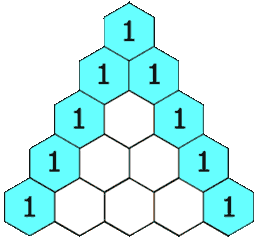118. Pascal's Triangle
Description
Given an integer numRows, return the first numRows of Pascal's triangle.
In Pascal's triangle, each number is the sum of the two numbers directly above it as shown:
Example 1:
Input: numRows = 5 Output: [[1],[1,1],[1,2,1],[1,3,3,1],[1,4,6,4,1]]
Example 2:
Input: numRows = 1 Output: [[1]]
Constraints:
1 <= numRows <= 30
Solutions
Solution 1: Simulation
First, we create an answer array \(f\), and then set the first row of \(f\) to \([1]\). Next, starting from the second row, the first and last elements of each row are \(1\), and the other elements are calculated by \(f[i][j] = f[i - 1][j - 1] + f[i - 1][j]\).
The time complexity is \(O(n^2)\), and the space complexity is \(O(n^2)\). Here, \(n\) is the number of rows.
1 2 3 4 5 6 7 | |
1 2 3 4 5 6 7 8 9 10 11 12 13 14 15 16 | |
1 2 3 4 5 6 7 8 9 10 11 12 13 14 15 16 17 | |
1 2 3 4 5 6 7 8 9 10 11 12 | |
1 2 3 4 5 6 7 8 9 10 11 12 | |
1 2 3 4 5 6 7 8 9 10 11 12 13 14 15 16 17 18 | |
1 2 3 4 5 6 7 8 9 10 11 12 13 14 15 16 | |

